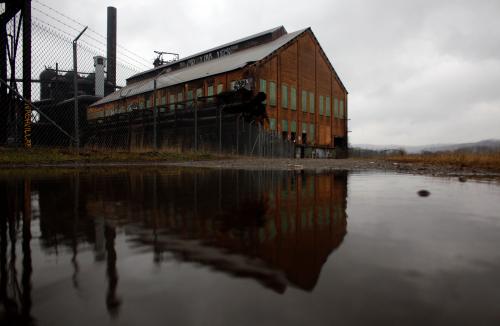With the recent passage of a new five-year, $305 billion surface transportation bill—Fixing America’s Surface Transportation (FAST) Act—Congress finally brokered a long-term agreement to address the nation’s infrastructure challenges. While the bill pumps needed spending into a range of highway, rail, and transit projects, albeit through some budgetary gimmicks, its most lasting achievement may center on freight.
As we have shown through the research of our Metro Freight series, investments in freight infrastructure are crucial to stitching together larger global value chains, growing local industries, and ultimately boosting regional economic growth. Whether improving connections to major metropolitan ports or relieving congestion at the worst highway bottlenecks, federal policymakers have a key role to play in promoting interstate commerce.
Until now, the country has operated without a coordinated freight strategy or investment program, limiting domestic and global economic competiveness. The FAST Act addresses this shortcoming by initiating multiple freight programs:
- First, as we previously recommended, it creates a new $4.5 billion competitive grant program, prioritizing “nationally significant freight and highway projects” in urban and rural areas across the country. The program not only awards grants to a wide variety of applicants, such as metropolitan planning organizations, port authorities, and other multi-state entities, but also covers an expansive number of eligible projects beyond highways, including those connected to major intermodal and port-related facilities.
- Second, it launches a new $6.3 billion freight formula program, aiming to target investments on a newly-designated “National Highway Freight Network” in addition to other critical urban and rural freight corridors. While the measures used to distribute this funding remain fairly narrow—largely focusing on mileage, similar to what was proposed in previous legislation—the program helps orient future federal efforts on economic concerns, including “industries and businesses that create high-value jobs.”
- Third, it requires the federal government and states to continually update their strategic planning process. The FAST Act continues the development of a national freight strategic plan, building on the impressive draft the U.S. Department of Transportation released this year. In particular, its need to highlight national investment needs in specific places could help guide the aforementioned grants. This kind of fiscally-constrained planning and the related advisory committees should lead to better coordination between freight investment and statewide industrial development.
- Finally, it begins to sketch out a new multimodal freight policy, strategic plan, and network. These combined efforts will better integrate the country’s transportation needs across all freight modes and facilities. In particular, identifying the country’s major freight gateways and bottlenecks will better position the nation’s trading economy by targeting investments with the greatest returns.
While the FAST Act represents a significant advance on federal freight policy, more work remains to be done. At a sub-national level, the continued need for more geographically-granular and industry-specific freight data should remain a top priority. If money can be authorized for trade-related data programs, Section 70203 of the act offers the guidance to create more valuable datasets. Likewise, state and metro leaders must continue building off this momentum and spearhead locally tailored freight solutions. The new requirement for state freight plans will help, but there is still a lack of clarity of how metropolitan areas can use the levers at their disposal—most notably land use controls—to successfully accommodate where goods flow and how they support development of all goods- and services-based industries.
But let’s not undersell what FAST accomplished. Between a combination of competitive investment, formula funding, and targeted reforms, we have the makings of a national freight policy.
The Brookings Institution is committed to quality, independence, and impact.
We are supported by a diverse array of funders. In line with our values and policies, each Brookings publication represents the sole views of its author(s).



Commentary
FAST Act ushers new era for U.S. freight policy
December 28, 2015